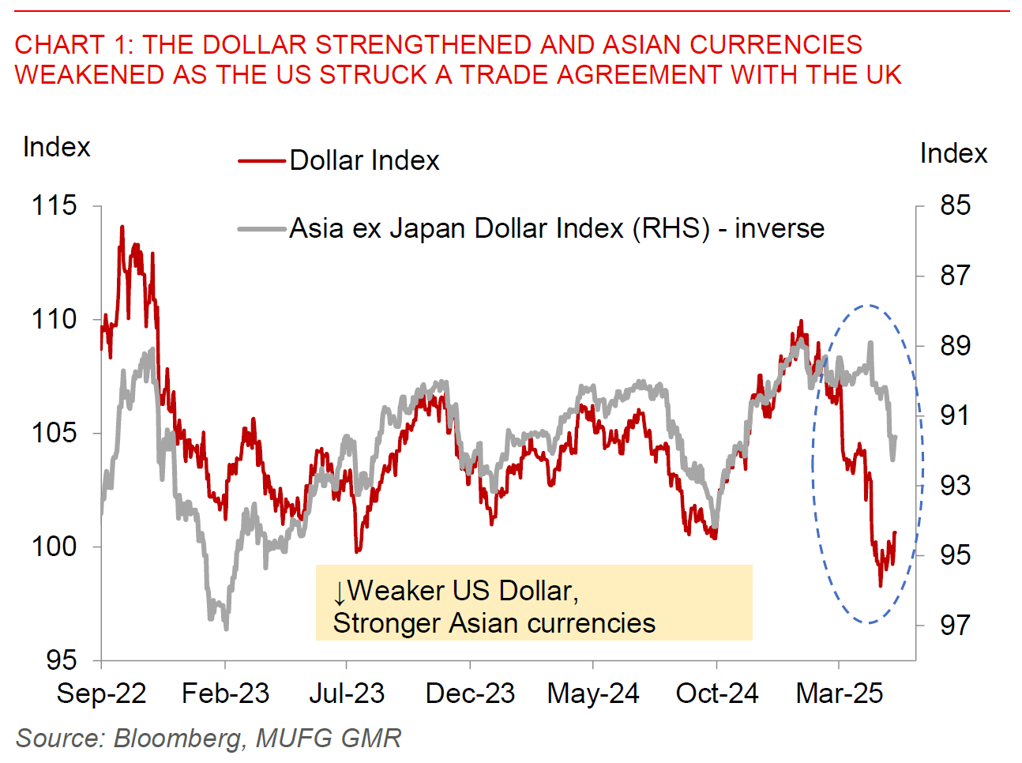Ahead Today
G3: US NY Fed President Williams and Waller Panel
Asia: China’s exports and imports
Market Highlights
President Trump announced a trade framework with the UK, which may provide clues on the path forward for deals with other countries including here in Asia. First, it seems the 10% base tariffs are mostly here to stay. Trump indicated that many countries (presumably those in Asia as well) will eventually get tariffs higher than 10% due to massive trade surpluses and unfair trade practices, in response to a question.
Second, the US is showing some flexibility on sectoral tariffs, which could have important implications for how other countries including Japan, South Korea and India negotiate with the US. In particular, the agreement with the UK authorised a quota to import 100,000 UK cars per year at a lower rate of 10% (relative to the original 25% auto tariff rate). In addition, it seems the UK could get a 0% tariff quota for steel and aluminum, but in exchange with cooperation with the US on a global trading agreement incorporating external barriers on these sectors (and presumably targeting China). According to the UK, pharmaceuticals will also be given preferential tariffs in upcoming changes. While details are still lacking and some information conflicting between the two sides, the key implication is that Trump is willing to negotiate tariff rate quotas on the Section 232 sectoral tariffs.

Third, agriculture access seems like an important part of the deal, with Trump claiming improved market access for the US, although the UK emphasized that it will retain food safety standards. Fourth, purchase commitments are important, with both sides highlighting a US$10bn Boeing aircraft deal. Lastly, there are no changes at the moment to digital taxes and regulation with the UK although it’s unclear whether this issue will be more important in negotiations with other markets such as Europe and other Asian countries with digital economy taxation and regulations.
Regional FX
Overall, the US Dollar strengthened by 1% and US equity markets rallied partly from the trade deal between the US and UK, while Asian currencies weakened in the broader backdrop of Fed Chair Powell’s reticence to signal rate cuts. Nonetheless, the key for markets will certainly be the upcoming US and China talks this weekend in Switzerland between China’s Vice Premier He Lifeng and US Treasury Secretary Scott Bessent and US Trade Representative Jamieson Greer. Reuters reported that the negotiating teams in Switzerland are expected to discuss reductions to the broader tariffs, with talks covering duties on specific products, export controls, and Trump’s decision to end de minimis exemptions on low-value imports. The NY Post meanwhile reported that the Trump administration is weighing a plan to reduce the 145% tariff on Chinese imports by more than half – effective as soon as next week – to between 50% and 54%. Meanwhile, trade taxes on neighbouring south Asian countries (presumably including Vietnam) will be cut to 25% according to the NY Post article. This would be consistent with our implicit expectation for Vietnam’s reciprocal tariff rate to be lowered from 46% to around 25%.
